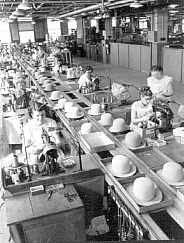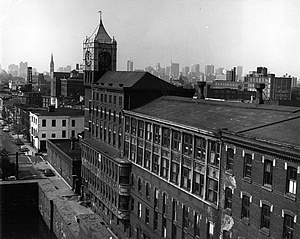
![]()
Johnnie Tillmon Townhouses
are located in a quiet, well-preserved rowhouse community—sometimes
called Old Kensington—of eastern North Philadelphia. Swiping through
Kensington is American Street, a wide industrial corridor that once included
a very busy railroad right-of-way along with the bustle of wagons and
trucks. American Street intersects with Germantown Avenue, a diagonal
artery that extends across the city to the northwestern neighborhoods
and into the suburbs. During the 19th century, the American Street-Germantown
Avenue area was one of the region's busiest job centers.
A major employer was the John B. Stetson Hat Manufactory, a company started in 1865, eventually becoming the largest hat maker in the world. Twenty-five buildings occupied nine acres in the vicinity of Germantown and Montgomery Avenues. In the 1920s, the plant employed more than 5,000 men and women and produced more than three million hats a year. Paternalistic John Stetson established employee institutions that included a school, a hospital, and a building-and-loan society that encouraged homeownership. The Great Depression of the 1930s and changing fashions ultimately crippled the company, and the plant closed in 1960. Today, the site is vacant land.
As Philadelphia's manufacturing sector declined during the late 20th century, many other companies in the vicinity of American Street and Germantown Avenue went out of business, leaving behind deteriorated, multistory, masonry structures that could not be readily adapted to modern industrial needs. In the 1970s, the City of Philadelphia began demolishing buildings and assembling parcels of land. The area became an attractive location for firms that valued the central location and reasonably good access to both city and suburban destinations. For example, two major food distribution companies, Honor Foods and Asia Foods, developed large facilities on cleared sites.
Urban
renewal funding helped finance repairs to many Kensington homes and supported
the development and operation of community facilities such as playgrounds
and senior centers. Under the Local Public Agency rehabilitation programs
of the 1970s, vacant houses were acquired and renovated by the Redevelopment
Authority of the City of Philadelphia and then sold to individual owners.
These improvements helped limit late-20th-century abandonment of housing,
which occurred in many nearby parts of Philadelphia. As a result, the
area contains a number of stable, well-maintained residential blocks that
have remained intact while the industrial zone has changed dramatically.
![]()
![]()

John
B. Stetson Hat Manufactory, assembly
line. 1952.

Vacant John B. Stetson
Hat Manufactory, exterior. August 9, 1977.